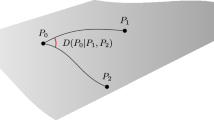Abstract
A gradient method is used to obtain least squares estimates of parameters of them-dimensional euclidean model simultaneously inN spaces, given the observation of all pairwise distances ofn stimuli for each space. The procedure can estimate an additive constant as well as stimulus projections and the metric of the reference axes of the configuration in each space. Each parameter in the model can be fixed to equal some a priori value, constrained to be equal to any other parameter, or free to take on any value in the parameter space. Two applications of the procedure are described.
Similar content being viewed by others
Reference notes
Carroll, J. D., Green, P. E., & Carmone, F. J.CANDELINC: A new method for multidimensional analysis with constrained solutions. Paper presented at the meeting of the International Congress of Psychology, Paris, France, July 1976.
Carroll, J. D., & Prezansky, S.MULTILINC: Multi-way CANDELINC. Paper presented at the meeting of the American Psychological Association, San Francisco, August 1977.
Gruvaeus, G. T., & Jöreskog, K. G.A computer program for minimizing a function of several variables (ETS RB-70-14). Princeton, N. J.: Educational Testing Service, 1970.
Noma, E., & Johnson, J.Constraining nonmetric multidimensional scaling configurations (Tech. Rep. 60). Ann Arbor: The University of Michigan, Human Performance Center, August 1977.
References
Abelson, R. P. A technique and a model of multidimensional attitude scaling.Public Opinion Quarterly, 1954,18, 405–418.
Bentler, P. M., & Weeks, D. G. Restricted multidimensional scaling models.Journal of Mathematical Psychology, 1978,17, 138–151.
Carroll, J. D., & Chang, J. J. Analysis of individual differences in multidimensional scaling via an N-way generalization of “Eckart-Young” decomposition.Psychometrika, 1970,35, 283–319.
Cooper, L. G. A new solution to the additive constant problem in metric multidimensional scaling.Psychometrika, 1972,37, 311–322.
Horan, C. B. Multidimensional scaling: Combining observations when individuals have different perceptual structures.Psychometrika, 1969,34, 139–165.
Jöreskog, K. G. A general approach to confirmatory maximum likelihood factor analysis.Psychometrika, 1969,34, 183–202.
Krane, W. R. Least squares estimation of individual differences in multidimensional scaling.British Journal of Mathematical and Statistical Psychology, 1978, (in press).
McGee, V. E. Multidimensional scaling of N sets of similarity measures: A nonmetric individual differences approach.Multivariate Behavioral Research, 1968,3, 233–248.
Schöneman, P. H. An algebraic solution for a class of subjective metrics models.Psychometrika, 1972,37, 441–451.
Seitz, V. R. Multidimensional scaling of dimensional preferences: A methodological study.Child Development, 1971,42, 1701–1720.
Torgerson, W. S.Theory and methods of scaling. New York: John Wiley & Sons, 1958.
Tucker, L. R. Relations between multidimensional scaling and three-mode factor analysis.Psychometrika, 1972,37, 3–27.
Zinnes, J. L., & Wolff, R. P. Single and multidimensional same-different judgements.Journal of Mathematical Psychology, 1977,16, 30–50.
Author information
Authors and Affiliations
Rights and permissions
About this article
Cite this article
Bloxom, B. Constrained multidimensional scaling inN spaces. Psychometrika 43, 397–408 (1978). https://doi.org/10.1007/BF02293648
Received:
Revised:
Issue Date:
DOI: https://doi.org/10.1007/BF02293648



